Petrogenesis and Geodynamics of the Huangnihe Pluton in the Jiapigou Mining District of Northeast China: Constraints from Zircon U–Pb and Lu–Hf Isotopes
Abstract
1. Introduction
2. Regional Geology and Geological Context of the Huangnihe Pluton
3. Results
3.1. Zircon U–Pb Geocronology
3.2. Zircon Lu–Hf Data
4. Discussion
4.1. Chronological Framework of Mesozoic Magmatism
4.2. Origin of the Huangnihe Pluton
4.3. Implications for Regional Geodynamic and Gold Mineralization
5. Conclusions
Supplementary Materials
Author Contributions
Funding
Data Availability Statement
Acknowledgments
Conflicts of Interest
References
- Sun, J.G.; Xing, S.W.; Zheng, Q.D. Geodynamic and Geochemistry of Nonferrous and Noble Metal Deposits, Northeastern China; Jilin University Press: Changchun, China, 2006; pp. 1–128. (In Chinese) [Google Scholar]
- Deng, J.; Yuan, W.M.; Carranza, E.J.M.; Yang, L.Q.; Wang, C.M.; Yang, L.Y.; Hao, N.N. Geochronology and thermochronometry of the Jiapigou gold belt, northeastern China: New evidence for multiple episodes of mineralization. J. Asian Earth Sci. 2014, 89, 10–27. [Google Scholar] [CrossRef]
- Han, J.L.; Deng, J.; Zhang, Y.; Sun, J.G.; Wang, Q.F.; Zhang, Y.M.; Zhang, X.T.; Liu, Y.; Zhao, C.T.; Yang, F.; et al. Au mineralization-related magmatism in the giant Jiapigou mining district of Northeast China. Ore Geol. Rev. 2022, 141, 104638. [Google Scholar] [CrossRef]
- Zhang, X.T.; Sun, J.G.; Han, J.L.; Feng, Y.Y. Genesis and mineralizing process of the Benqu mesothermal gold deposit in the Jiapigou ore cluster, NE China: Constraints from geology, geochronology, fluid inclusions, and whole-rock and isotope geochemistry. Ore Geol. Rev. 2021, 130, 103956. [Google Scholar] [CrossRef]
- Han, J.L.; Lü, Z.C.; Zhao, C.T.; Zhang, X.T.; Sun, J.G.; Wang, S.; Zhang, X.W. Ore genesis of the Jurassic granite-hosted Naizhigou gold deposit in the Jiapigou District of Northeast China: Constraints from Fluid Inclusions and H–O–S Isotopes. Minerals 2025, 15, 696. [Google Scholar] [CrossRef]
- Deng, J.; Wang, Q. Gold mineralization in China: Metallogenic provinces, deposit types and tectonic framework. Gondwana Res. 2016, 36, 219–274. [Google Scholar] [CrossRef]
- Wang, Q.F.; Zhao, H.S.; Yang, L.; Groves, D.I.; Han, J.L.; Qiu, K.F.; Li, D.P.; Liu, Z.; Zhao, R.; Deng, J. Formation of the giant Cretaceous Jiaodong-type orogenic gold province of the North China Craton: A consequence of lithospheric multi-layer reworking. Geosci. Front. 2025, 16, 102047. [Google Scholar] [CrossRef]
- Yu, B.; Zeng, Q.D.; Frimmel, H.E.; Wang, Y.B.; Guo, W.K.; Sun, G.T.; Zhou, T.C.; Li, J.P. Genesis of the Wulong gold deposit, northeastern North China Craton: Constraints from fluid inclusions, H–O–S–Pb isotopes, and pyrite trace element concentrations. Ore Geol. Rev. 2018, 102, 313–337. [Google Scholar] [CrossRef]
- Liu, C.; Zhu, G.; Xie, C.L.; Zhang, S.; Li, Y.J.; Su, N.; Xiao, S.Y. Location and sinistral displacement of the eastern Liaoyuan Accretionary Belt along the Tan–Lu Fault Zone, NE China. J. Asian Earth Sci. 2019, 172, 409–422. [Google Scholar] [CrossRef]
- Huang, Z.X. Tectonics–Fluids–Mineralization System of Jiapigou Gold Belt in the Jilin Province, China. Ph.D. Thesis, China University of Geosciences Beijing, Beijing, China, 2021; pp. 1–255, (In Chinese with English Abstract). [Google Scholar]
- Liu, S.; Hu, R.Z.; Feng, C.X.; Feng, G.Y.; Yu, X.F.; Li, C.; Jia, D.C.; Qi, Y.Q.; Wang, T. Zircon U–Pb age, Hf isotopic compositions of Dapuchaihe adakites in eastern Jilin Province and their significance. Acta Petrol. Sin. 2009, 25, 3153–3164, (In Chinese with English Abstract). [Google Scholar]
- Wang, S.; Sun, J.G.; Han, J.L.; Chu, X.L.; Zhang, X.T. Genesis, magmatic process and metallogenic constraints on the granitic complex in the Jiapigou gold mining district, Jilin Province: Evidence from zircon U–Pb geochronology and element and Hf isotope geochemistry. Geol. J. 2025; (submitted for publication). [Google Scholar]
- Yu, R.D.; Sun, J.G.; Wang, S.; Han, J.L.; Liu, Y. Neoarchean–early Paleoproterozoic crustal evolution in the Jiapigou terrane in the northeastern part of the North China Craton: Geochemistry, zircon U–Pb dating and Hf isotope constraints from the potassic granitic complex. Precambrian Res. 2021, 364, 106341. [Google Scholar] [CrossRef]
- Han, J.L.; Sun, J.G.; Zhang, X.T.; Liu, Y.; Xu, Z.K.; Wang, S.; Xu, Z.T.; Li, X. Comparison of vein- and breccia-type Au-mineralization in the giant Jiapigou mining district of Northeast China. Ore Geol. Rev. 2022, 141, 105173. [Google Scholar] [CrossRef]
- Song, B.; Zhang, Y.H. Introduction to the naissance of SHRIMP and its contribution to isotope geology. J. Chin. Mass Spectrom. Soc. 2002, 23, 58–62, (In Chinese with English Abstract). [Google Scholar]
- Griffin, W.L.; Wang, X.; Jackson, S.E.; Pearson, N.J.; O’Reilly, S.Y.; Xu, X. Zircon chemistry and magma mixing, SE China: In-situ analysis of Hf isotopes, Tonglu and Pingtan igneous complexes. Lithos 2002, 61, 237–269. [Google Scholar] [CrossRef]
- Anderson, T. Correction of common lead in U–Pb analyses that do not report 204Pb. Chem. Geol. 2002, 192, 59–79. [Google Scholar] [CrossRef]
- Ludwig, K.R. User’s Manual for Isoplot 3.0: A Geolocronolgical Toolkit for Microsoft Excel; Berkeley Geochronlogical Center, Special Publication: Berkeley, CA, USA, 2003; Volume 4, pp. 1–70. [Google Scholar]
- Wu, Y.B.; Zheng, Y.F. Genesis of zircon and its constraints on interpretation of U–Pb age. Chin. Sci. Bull. 2004, 49, 1554–1569, (In Chinese with English Abstract). [Google Scholar] [CrossRef]
- Zhang, Y.B.; Wu, F.Y.; Zhai, M.G.; Lu, X.P. Tectonic characteristics of the Helong Block and the boundary of eastern segment of the northern margin of the North China Craton. Sci. China Earth Sci. 2004, 34, 795–806. (In Chinese) [Google Scholar]
- Han, J.L. Metallogenesis and Geodynamic Setting of the Typical Gold Deposits in the Liuhe Area of the Huadian City, Jilin Province. Ph.D. Thesis, Jilin University, Changchun, China, 2019; pp. 1–154, (In Chinese with English Abstract). [Google Scholar]
- Lu, Y. Petrology and Geochemistry of Early Jurassic Intrusive Rocks in the Central Jilin Province. Ph.D. Thesis, Jilin University, Changchun, China, 2016; pp. 1–68, (In Chinese with English Abstract). [Google Scholar]
- Li, L. Research on Ore-Forming Fluids of Gold Deposits in Jiapigou-Haigou Gold Belt, Jilin Province and Deep-Seated Metallogenic Assessment. Ph.D. Thesis, Jilin Univertsity, Changchun, China, 2016; pp. 1–111, (In Chinese with English Abstract). [Google Scholar]
- Zhang, Y.B.; Wu, F.Y.; Wilde, S.A.; Zhai, M.G.; Lu, X.P.; Sun, D.Y. Zircon U–Pb ages and tectonic implications of ‘Early Paleozoic’ granitoids at Yanbian, Jilin Province, northeast China. Isl. Arc 2004, 13, 484–505. [Google Scholar] [CrossRef]
- Liu, D.Z.; Qu, S.; Wang, X.G. The basic geological features of the Huangniling rock body. Jilin Geol. 1994, 13, 41–49. [Google Scholar]
- Defant, M.J.; Jackson, T.E.; Drummond, M.S.; de Boer, J.Z.; Bellon, H.; Feigenson, M.D.; Maury, R.C.; Stewart, R.H. The geochemistry of young volcanism throughout Western Panama and Southern Casta Rica, an overview. J. Geol. Soc. 1992, 149, 569–579. [Google Scholar] [CrossRef]
- Xu, W.L.; Pei, F.P.; Wang, F.; Meng, E.; Ji, W.Q.; Yang, D.B.; Wang, W. Spatial–temporal relationships of Mesozoic volcanic rocks in NE China: Constraints on tectonic overprinting and transformations between multiple tectonic regimes. J. Asian Earth Sci. 2013, 74, 167–193. [Google Scholar] [CrossRef]
- Han, J.L.; Lü, Z.C.; Zhang, X.T.; Liu, Y.; Yu, X.F.; Zhao, C.T.; Sun, J.G.; Huang, P.F.; Wang, S.; Zhang, X.W. Middle Jurassic giant Au-mineralization in the Jiapigou district of NE China: Constrains from zircon U–Pb and molybdenite Re–Os dating of the Naizhigou deposit. Ore Geol. Rev. 2025; (submitted for publication). [Google Scholar]
- Mooney, W.D.; Laske, G.; Masters, T.G. Crust 5.1: A global crustal model at 5° × 5°. J. Geophys. Res. 1998, 103, 727–747. [Google Scholar] [CrossRef]
- McQuarrie, N.; Chase, C.G. Raising the Colorado Plateau. Geology 2000, 28, 91–94. [Google Scholar] [CrossRef]
- Platt, J.P. From orogenic hinterlands to Mediterranean-style back-arc basins: A comparative analysis. J. Geol. Soc. 2007, 164, 297–311. [Google Scholar] [CrossRef]
- Zhang, C.H.; Li, C.M.; Deng, H.L.; Liu, Y.; Liu, L.; Wei, B.; Li, H.B.; Liu, Z. Mesozoic contraction deformation in the Yanshan and northern Taihang mountains and its implications to the destruction of the North China Craton. Sci. China Earth Sci. 2011, 54, 798–822. [Google Scholar] [CrossRef]
- Xue, J.X.; Cai, K.D.; Zhang, Z.J.; Wang, K. Timing and style of final closure of the Paleo-Asian Ocean: Perspectives from the Big Geodata Analysis and machine learning model. J. Geophys. Res. Solid Earth 2025, 130, e2024JB029877. [Google Scholar] [CrossRef]
- Hu, F.Y.; Ducea, M.N.; Liu, S.W.; Chapman, J.B. Quantifying crustal thickness in continental collisional belts: Global perspective and a geologic application. Sci. Rep. 2017, 7, 7058. [Google Scholar] [CrossRef]
- Profeta, L.; Ducea, M.N.; Chapman, J.B.; Paterson, S.R.; Gonzales, S.M.H.; Kirsch, M.; Petrescu, L.; DeCelles, P.G. Quantifying crustal thickness over time in magmatic arcs. Sci. Rep. 2015, 5, 17786. [Google Scholar] [CrossRef] [PubMed]
- Wu, F.Y.; Sun, D.Y.; Ge, W.C.; Zhang, Y.B.; Grant, M.L.; Wilde, S.A.; Jahn, B.M. Geochronology of the Phanerozoic granitoids in northeastern China. J. Asian Earth Sci. 2011, 41, 1–30. [Google Scholar] [CrossRef]
- Thieblemont, D.; Stein, G.; Lescuyer, J.L. Gisements epithermaux et porphyrigues: La connexion adakite. Earth Planet. Sci. 1997, 325, 103–109. [Google Scholar]
- Zhang, Y.; Tian, J.; Hollings, P.; Gong, L.; Alburo, I.; Berador, A.E.; Francisco, D.G. Mesozoic porphyry Cu–Au mineralization and associated adakite-like magmatism in the Philippines: Insights from the giant Atlas deposit. Miner. Depos. 2019, 55, 881–900. [Google Scholar] [CrossRef]
- Zhang, L.Y.; Li, S.C.; Zhao, Q.Y. A review of research on adakites. Int. Geol. Rev. 2021, 63, 47–64. [Google Scholar] [CrossRef]
- Li, J.X.; Qin, K.Z.; Li, G.M.; Xiao, B.; Chen, L.; Zhao, J.X. Post-collisional ore-bearing adakitic porphyries from Gangdese porphyry copper belt, southern Tibet: Melting of thickened juvenile arc lower crust. Lithos 2011, 126, 265–277. [Google Scholar] [CrossRef]
- Fu, L.B.; Wei, J.H.; Kusky, T.M.; Chen, H.Y.; Tan, J.; Li, Y.J.; Shi, W.J.; Chen, C.; Zhao, S.Q. The Cretaceous Duimiangou adakite-like intrusion from the Chifeng region, northern North China Craton: Crustal contamination of basaltic magma in an intracontinental extensional environment. Lithos 2012, 134–135, 273–288. [Google Scholar] [CrossRef]
- Liu, L.; Gu, X.X.; Zhang, Y.M.; Ouyang, X.; Wang, L.Z.; Gao, L.Y. Genesis of the Jinchanggouliang gold deposit, Chifeng, China: Constraints from fluid inclusions and isotopic geochemistry. Ore Geol. Rev. 2019, 115, 103180. [Google Scholar] [CrossRef]
- Sun, J.G.; Liu, Y.; Xu, Z.K.; Xu, Z.T.; Chu, X.L.; Gu, A.L. Large-scale epithermal mineralization of late Mesozoic and the constraints of deep geological processes on mineralization in the continental margin of NE China. J. Jilin Univ. (EarthScience Ed.) 2023, 53, 651–692, (In Chinese with English Abstract). [Google Scholar]
- Qiao, S.L.; Ma, X.H. Geochronological and geochemical constraints on age and origin of granodiorite of Nongping Au-Cu porphyry deposit in Jilin Province, China. Miner. Depos. 2018, 37, 387–402, (In Chinese with English Abstract). [Google Scholar]
- Cooke, D.R.; Hollings, P.; Walsh, J.L. Giant porphyry deposits: Characteristics, distribution, and tectonic controls. Econ. Geol. 2005, 100, 801–818. [Google Scholar] [CrossRef]
- Sillitoe, R.H. Porphyry copper systems. Econ. Geol. 2010, 105, 3–41. [Google Scholar] [CrossRef]
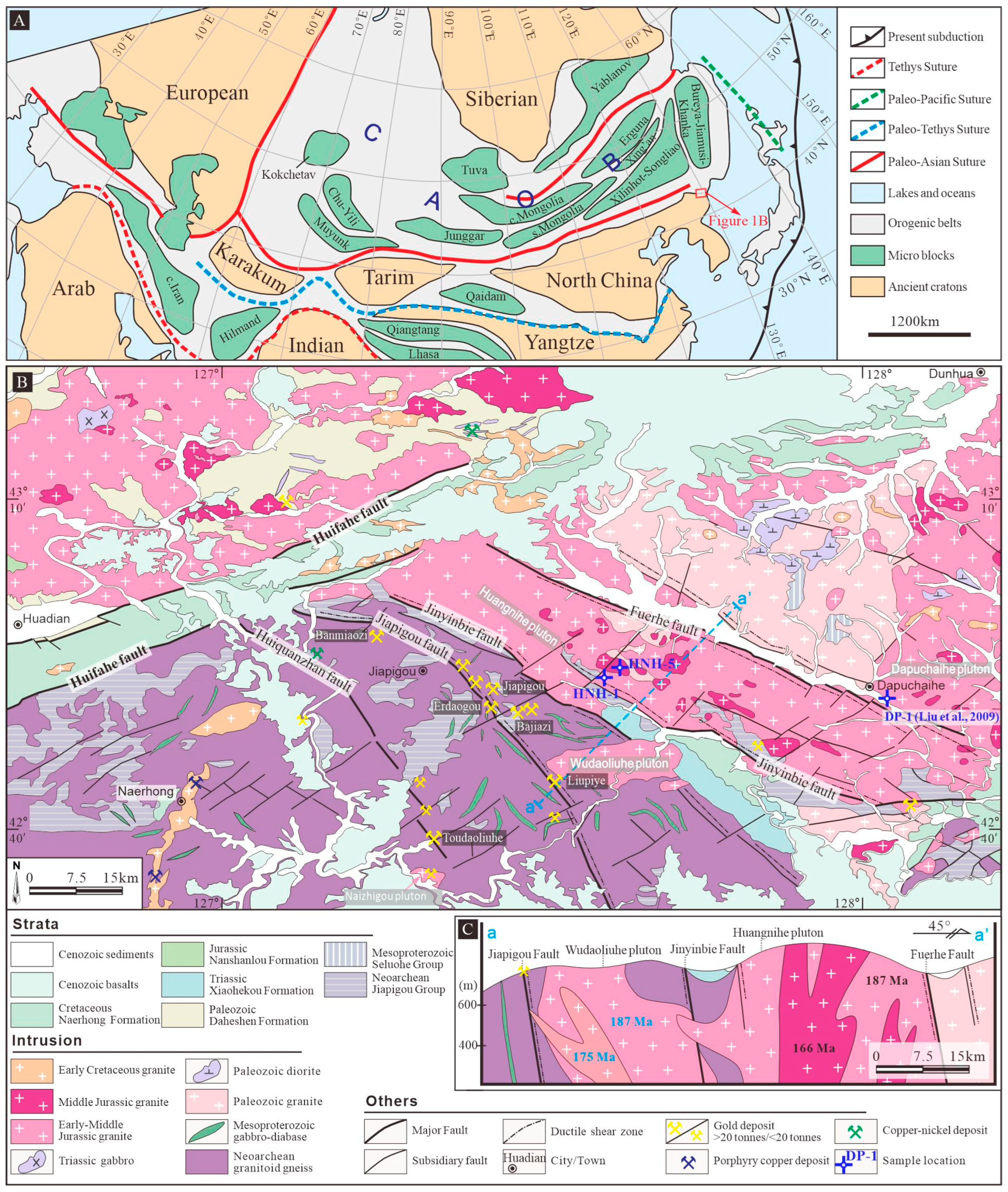
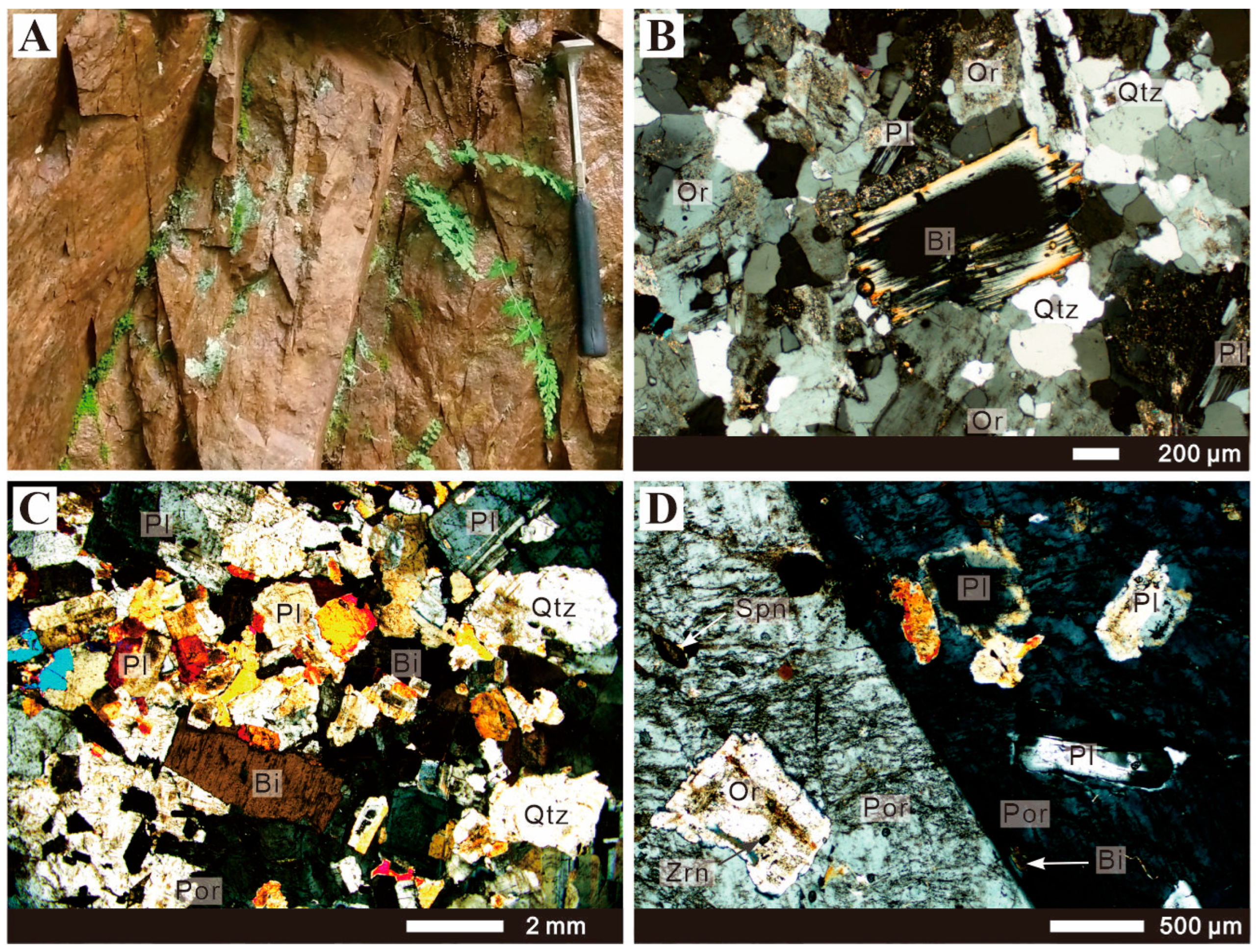
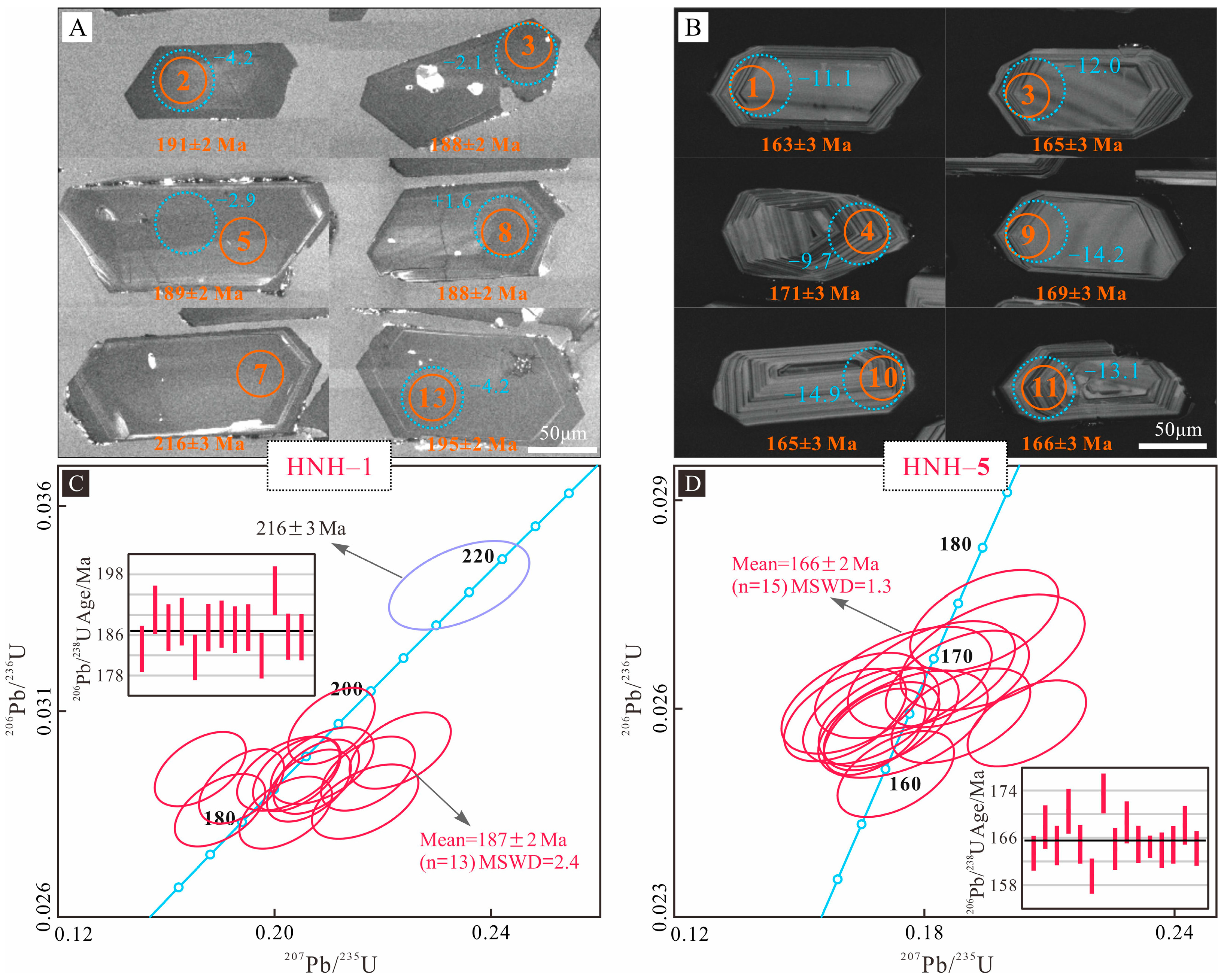
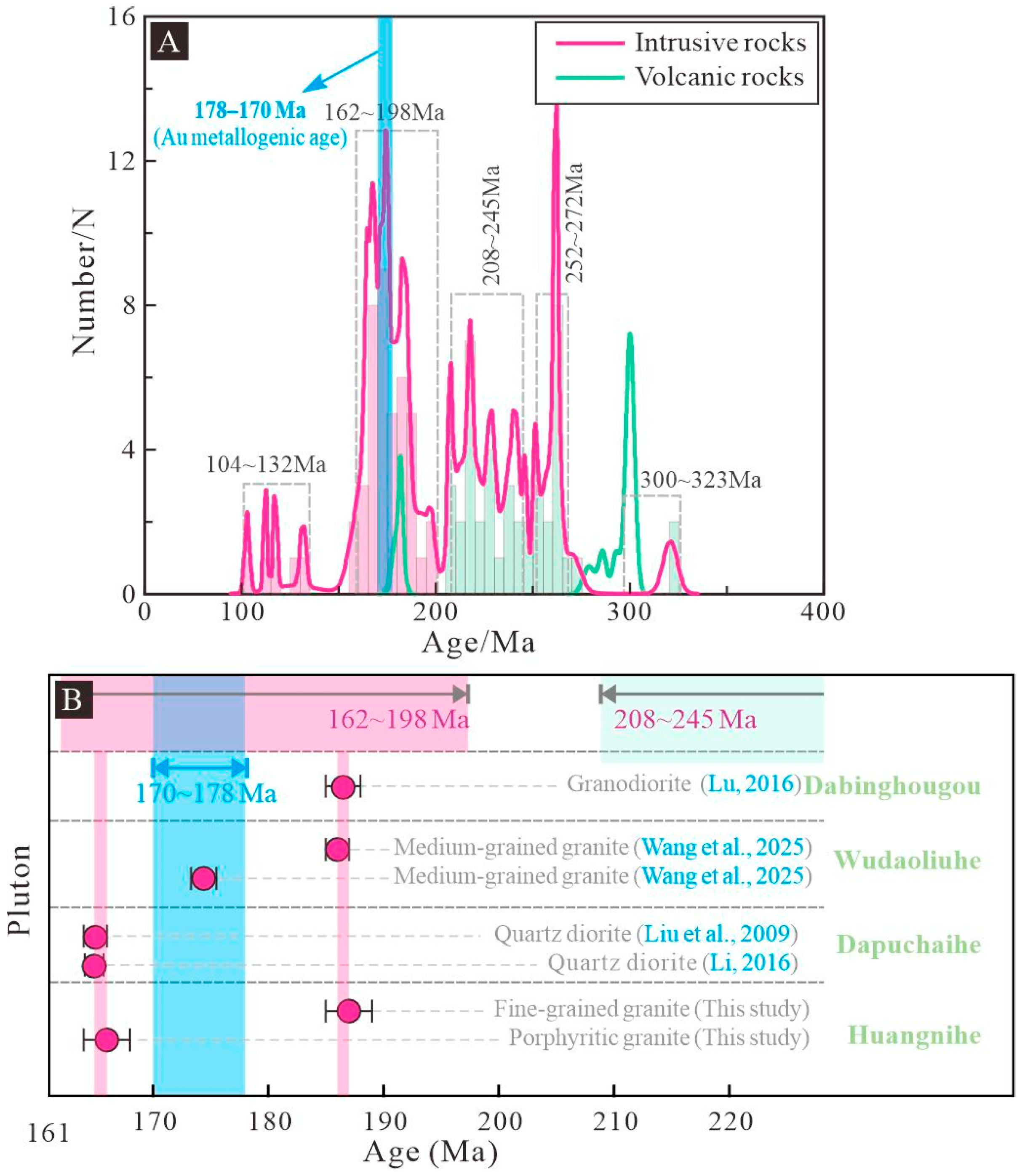
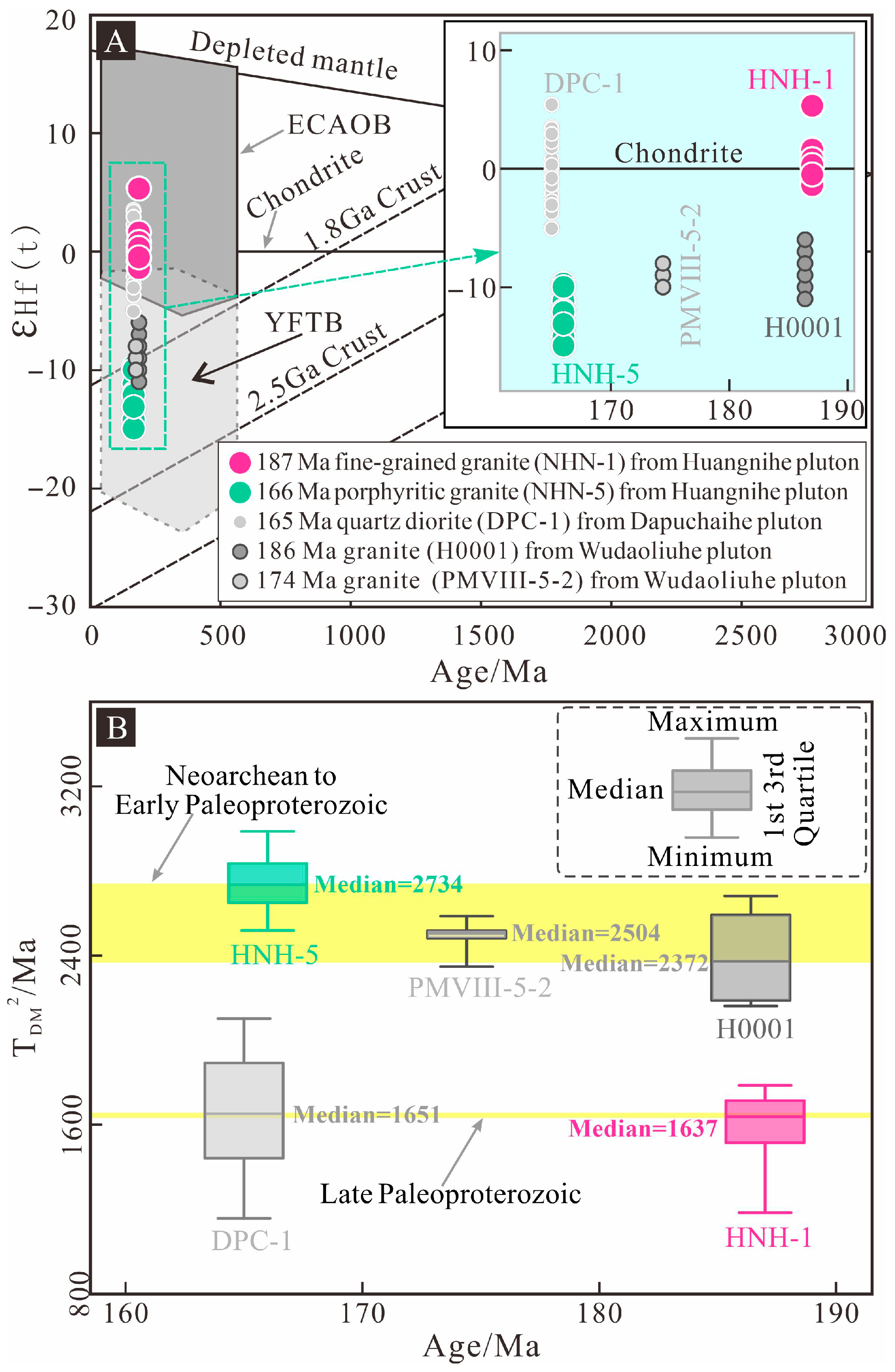
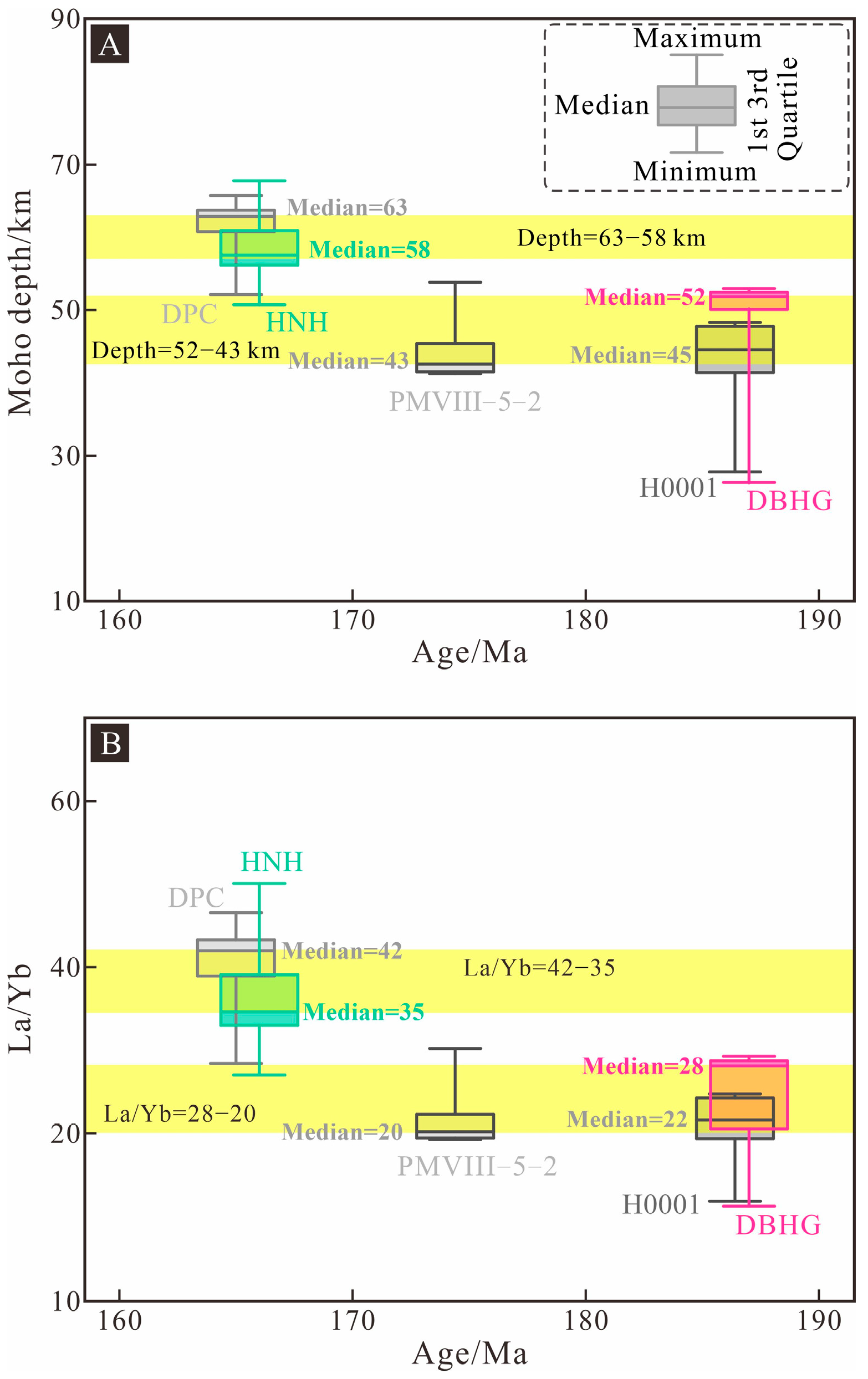
Disclaimer/Publisher’s Note: The statements, opinions and data contained in all publications are solely those of the individual author(s) and contributor(s) and not of MDPI and/or the editor(s). MDPI and/or the editor(s) disclaim responsibility for any injury to people or property resulting from any ideas, methods, instructions or products referred to in the content. |
© 2025 by the authors. Licensee MDPI, Basel, Switzerland. This article is an open access article distributed under the terms and conditions of the Creative Commons Attribution (CC BY) license (https://creativecommons.org/licenses/by/4.0/).
Share and Cite
Han, J.; Lü, Z.; Liu, Y.; Qin, X.; Zhang, X.; Huang, P.; Zhang, X.; Wang, S.; Zhao, C.; Sun, J. Petrogenesis and Geodynamics of the Huangnihe Pluton in the Jiapigou Mining District of Northeast China: Constraints from Zircon U–Pb and Lu–Hf Isotopes. Minerals 2025, 15, 1014. https://doi.org/10.3390/min15101014
Han J, Lü Z, Liu Y, Qin X, Zhang X, Huang P, Zhang X, Wang S, Zhao C, Sun J. Petrogenesis and Geodynamics of the Huangnihe Pluton in the Jiapigou Mining District of Northeast China: Constraints from Zircon U–Pb and Lu–Hf Isotopes. Minerals. 2025; 15(10):1014. https://doi.org/10.3390/min15101014
Chicago/Turabian StyleHan, Jilong, Zhicheng Lü, Yanpeng Liu, Xuliang Qin, Xiaotian Zhang, Pengfei Huang, Xinwen Zhang, Shu Wang, Chuntao Zhao, and Jinggui Sun. 2025. "Petrogenesis and Geodynamics of the Huangnihe Pluton in the Jiapigou Mining District of Northeast China: Constraints from Zircon U–Pb and Lu–Hf Isotopes" Minerals 15, no. 10: 1014. https://doi.org/10.3390/min15101014
APA StyleHan, J., Lü, Z., Liu, Y., Qin, X., Zhang, X., Huang, P., Zhang, X., Wang, S., Zhao, C., & Sun, J. (2025). Petrogenesis and Geodynamics of the Huangnihe Pluton in the Jiapigou Mining District of Northeast China: Constraints from Zircon U–Pb and Lu–Hf Isotopes. Minerals, 15(10), 1014. https://doi.org/10.3390/min15101014







